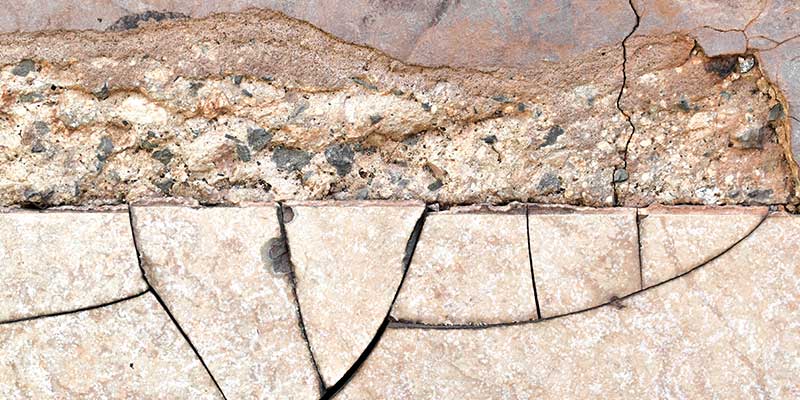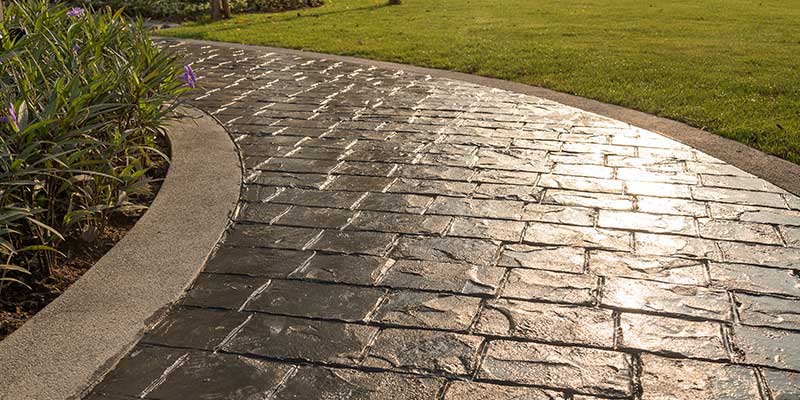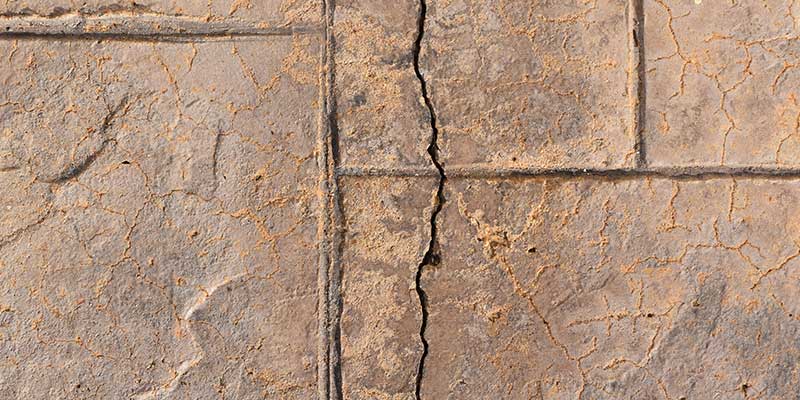When concrete problems such as surface cracks, spalling, fading color, or chipped edges appear on a concrete driveway or patio, addressing them promptly prevents further damage and restores the attractive concrete look you invested in.
In this guide, our expert concrete contractors explain how to repair stamped concrete so you can address it correctly and save money. Let’s dive in!

Understanding Stamped Concrete & Its Common Issues
Freeze-thaw cycles, de-icing salts, over-finishing, and UV rays introduce additional issues, such as flaking surfaces, uneven tones, or white mineral deposits that dull the concrete’s appearance.
Although most flaws are cosmetic, unattended deterioration can expose aggregate, weaken the texture, and allow moisture intrusion, shortening the material’s life. Prompt concrete repair keeps small flaws from evolving into structural concerns that compromise the slab’s integrity.
How to Repair Your Stamped Concrete Surfaces

Surface Preparation: The Foundation of Every Successful Repair
Wash the area with a mild detergent and water; stubborn grime or oil may require a degreasing product or low-pressure washing to lift trapped dirt. If an earlier sealer has turned cloudy or begun to peel, remove it with a chemical stripper, light grinding, or gentle sandblasting until the slab feels porous underfoot.
Open any hairline cracks with a crack-chasing blade or cold chisel to create a slight V-groove, then rinse thoroughly and allow the surface to dry. This careful preparation promotes strong adhesion for patch mixes, stains, and new sealers, laying the groundwork for professional-quality concrete restoration.
Repairing Hairline Cracks
Blend the powder with just enough water to resemble thick pudding, then press this paste into the prepared groove, forcing it deep into the void. Level the filler so it sits flush with the surrounding texture, and lightly wipe away the excess with a damp sponge before it sets.
After curing, the repaired line blends with the surrounding decorative concrete and virtually disappears once the slab is resealed.
Patching Chips, Pop-Outs, & Spalled Areas
Chipped edges, small pop-outs, and localized spalling often occur along pattern joints or high-traffic walk lines. Effective repair methods require rebuilding missing mass with a polymer-modified patch mortar or a custom mix of fine sand, cement, and matching color hardener.
Begin by slightly undercutting the cavity so the bottom is wider than the top, which gives the patch a mechanical lock. Lightly dampen the substrate to a saturated-surface-dry state, pack the mortar firmly into place, and smooth it level. While the mix is still plastic, press a scrap of matching stamp mat, sponge, or even a lightly oiled piece of the original stamping tools against the surface to recreate the pattern.
Once cured, the repaired area should feel solid and blend invisibly with the surrounding concrete surface.
Restoring Color
Sunlight, snow shovels, and ordinary wear can fade or mottle a patterned slab’s colors. Uniform restoration is possible with integral concrete stains or antiquing washes. Water- or solvent-based stains soak into the surface, reviving the field colour in broad strokes, while antiquing washes settle in relief areas and deepen the shadows that give stamped patterns depth. Always test in a discreet corner to confirm the desired colour.
After the stain dries, evaluate for consistent hue; a second light application can even out stubborn blotches or highlight grout lines in multi-tone designs.

Sealing for Protection & Enhancement
A high-quality exterior sealer shields stamped concrete from moisture, salts, and UV rays, while enriching texture and hue. Acrylic sealers remain popular for paving applications because they breathe and refresh easily. Two thin coats applied with a roller or pump sprayer create a uniform sheen without puddling, resist peeling, and enhance the depth of the pattern.
Regular resealing every couple of years—or sooner on heavily trafficked driveway slabs—maintains color vibrancy and reinforces the protective layer that modern concrete cures demand.
Concrete Overlays for Extensive Damage
When large areas of scaling, widespread surface cracks, or pervasive color loss outweigh spot repairs, a concrete overlay system offers a fresh start without complete replacement. A polymer-modified topping, typically one-quarter to one-half inch thick, is troweled over the prepared slab, colored with release agent, and re-stamped to a new pattern. The overlay bonds tenaciously to the substrate and receives stains and sealers like new work, effectively restoring form and function in a single installation.
Because overlays require strict control of working time, bond strength, and finishing, they are best executed by an experienced concrete contractor.
When to Call a Professional
Most owners can handle low-risk cosmetic fixes, yet certain conditions require expert intervention. Wide, deep cracks that travel through the entire slab may signal subgrade movement or poor compaction.
Persistent moisture or salt scaling on a concrete driveway subjected to de-icers can require industrial coatings or densifiers unavailable at retail. Large-scale color correction, pattern re-texturing, or installation of overlays likewise benefits from professional skill and specialized tools.
Contractors like our experts at FerCo Construction supply higher-grade materials and diagnose hidden issues, such as drainage failures, that contribute to recurring damage.
кракен онион ссылка kraken one com kra cc ссылка кракен даркнет маркет зеркало кракен кракен dark market кракен darknet market ссылка используйте vpn кракен маркет даркнет тор кракен сайт что это kraken ссылка тор кракен.ат

Restore Your Concrete to Its Old Glory!
Understanding how to repair stamped concrete empowers homeowners to preserve the beauty and longevity of their outdoor investment. You can restore the rich hues and crisp patterns of decorative concrete through meticulous surface preparation, color-matched mortars, and protective sealing.
If you require further assistance with major repairs, refer to our professional concrete contractors. Our team can address any concrete repairs on time and budget. Make your inquiries today!

